posters
Blue Plate Special
Kimberly from Australia emails:
“[I am writing] to see if you have a copy of Tibor Kalman’s ‘Fuck Bush. Vote’ poster. Reading your post today about the bilingual poster for the NYC elections made me remember Tibor’s and would love to see it.”
Here you go. A shot of page 75 in Tibor Kalman: Perverse Optimist:
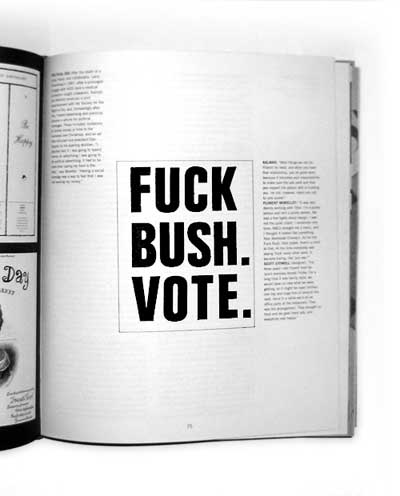
Before his famous “political advertising” for Benetton, Kalman and his company M&Co created such at the behest of Florent Morellet, owner of the eponymous bistro in the meatpacking district.
The text on the page above reads:
“After the death of a close friend, and collaborator Larry Rosenberg, in 1987, after a prolonged struggle with AIDS (and a medical profession caught unawares), Kalman and Morellet produced a joint advertisement with the Society for the Right to Die, and, increasingly after this, Florent advertising and publicity became a vehicle for political messages. These included invitations to donate money or time to the homeless over Christmas, and an ad that ridiculed vice-president Dan Quayle for his spelling abilities.
‘I decided that if I was going to spend money on advertising I was going to do political advertising; it had to be more than saying my food is the best,’ says Morellet. ‘Having a social message was a way to feel that I was not wasting my money.’
Kalman: ‘Most things we did for Florent he liked, and when you have that relationship, you do great work, because it becomes your responsibility to make sure the ads work and that you respect the person who is trusting you. He did, however, reject our call to vote poster.’Florent Morellet: ‘It was very stormy working with Tibor. I’m a pushy person and he’s a pushy person. We had a few fights about design. I was not the quiet client.... As for the Fuck Bush, Vote poster, there’s a limit to that. At the time everybody was saying ‘fuck’ every other word. It became boring, like ‘you see.’’
Scott Stowell (designer): ‘For three years I ate Florent food for lunch everyday except Friday. For a long time it was family style; we would have no idea what we were getting, so it might be roast chicken one day and huge tins of borscht the next. Once in a while we’d do an office party at the restaurant. That was the arrangement. They brought us food and we gave them ads, and everybody was happy.’”
Florent has a history of community engagement. In 2003, with preservationist Jo Hamilton, he helped earn landmark recognition for the Gansevoort Historic District.
The context of the Florent ads, arising from rage and personal loss, and even the barter arrangement, make the feel a lot less crass and gratuitously provocative than Kalman’s later work for Benetton.
---
See previous posts Half Empty on Tibor and Commodify Your Dissent on merchant politics.
Get Out the Vote
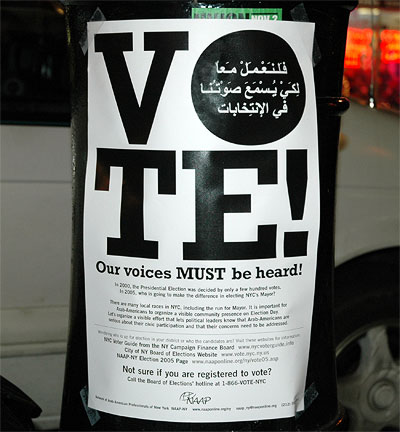
It’s election day today in NYC. I spotted this in Bay Ridge Brooklyn this weekend.
The bilingual poster does not endorse a particular candidate or ballot initiative, simply the vote itself. It’s not trying to sell anything but political power.
The poster reads:
“There are many local races in NYC, including the run for Mayor. It is important for Arab-Americans to organize a visible community presence on Election Day. Let’s organize a visible effort that lets political leaders know that Arab-Americans are serious about their civic participation and that their concerns need to be addressed.”
Political power in New York City can often be drawn among community lines. This often becomes a game of numbers, and graphics in community spaces play a small but important part.
Class Action
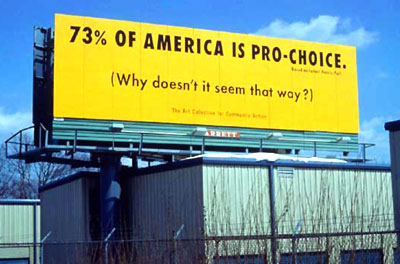
Class Action bills itself as “The Art Collective for Community Action.”
From classactioncollective.org:
“Class Action creates visual messages to advocate social change. Our goal is to influence the way public issues are understood, and motivate audiences to participate in civic dialogue. We work as a collective, authoring, producing and publishing our ideas & initiating projects to illuminate attitudes and conditions overlooked in mainstream media.
Our work originates outside of the studio, with a perception of something taking place in the world. Often beginning with the newspaper or newscast, we define an issue, research it, and craft a message that can lead to some real-world action or change. We work in the spirit of the phrase, ‘pro bono publico’, meaning ‘for the public good’. We endeavor not only to communicate our own position but also to inspire others to become active.
As graphic designers, we have the power to lend authority to messages that would normally be seen on the fringes of society. Through design, we gain access to the official channels of communication & the organizations, institutions, leaders and media that have great sway over social values and priorities. What we place in these channels is an attempt to challenge, influence and provoke.”
Class Action started as just that, in 1992 at the Yale School of Art. Several designers have been associated with the collective since then.
Check their list of public projects. Among them:
- T-shirts and an exhibition on AIDS awareness
- a talk show media kit and T-shirt on the “abortion pill” RU-486
- a poster challenging the gender bias of AIGA
- a billboard on domestic violence
- a public service announcement on teen pregnancy
- and posters on gun control
My personal favorite is this surreptitious pamphlet challenging the AIGA’s commitment to public engagement:
“Washington DC, 2002: The American Institute of Graphic Arts National Conference ‘Voice!’ promises a radically new focus on serious public issues. Yet the AIGA design competitions criteria continue to emphasize form over content. The satirical pamphlet, written and designed to conform to the identity of the conference materials, challenges the AIGA to recognize the purpose and social value of design.”
From the pamphlet:
“New Categories for 365: AIGA annual design competitions
The new competitions will reward design that best works toward:
- Establishing justice
- Insuring domestic tranquility
- Providing for the common defense
- Promoting the general welfare
- Securing the blessings of liberty
- Forming a more perfect union
By the end of voice we trust you will agree that these criteria and categories are what really matter.”
The common defense bit gets a bit murky in this perpetual “war on terror”, but I think the piece hits the right place at the right time. Within the context of the membership conference, it starts to move beyond public awareness into mobilization. Nice to see the Left seizing ‘American-ness,’ too.
I’ve argued here before about how the AIGA and competitions could be a force for change, so it’s nice to see AIGA members taking them to task, too — and nearly a month before I started this blog!
Here’s looking forward to more work — and to keeping the pressure on!
Guernica, USA
John T. Unger writes in about his campaign:
“I thought you might be interested in helping spread the word about a call for participation. I’m looking for artists/activists who can help get billboard sized reproductions of Picasso’s Guernica installed in as many US locations as possible.”

From his blog:
“Ideally, the work would stand without any text or headlines or additional commentary: if the painting is all that’s seen, it forces the viewer to make an interpretation instead of being told what to think. Being told what to think is exactly what got Americans in trouble in the first place, no?
In terms of how the project is carried out, I don’t really think it matters whether billboards are rented, plastered over in dark of night (see: BLF, the Billboard Liberation Front) or created just for this purpose. Obviously not everyone has the budget to actually rent billboard space, though it seems like this might be an option for funded activist groups. Now that most billboards are made to hold printed tarps rather than pasted up sheets of paper, it would certainly be easier and faster for guerrilla Guernicas to be painted on canvas and installed at whim. For those who do take the guerrilla approach, it might help to read this basic primer on how to appropriate billboards. Also check out the Wooster Collective for ideas and techniques.
I don’t think it matters whether the images are photos, stencils, handpainted, collaged or what. If the project really took off, part of the excitement would be seeing the results of many different people interpreting a well know work in their own way. I will happily publish any photos sent in by participants of the project.”
The project is, in part, a test of his idea of “open-sourcing art projects” to involve as many participants as possible.
Quickies
Danish anti-war posters hit Iraq:
“On Friday, Iraqis started hanging over 1000 posters created by the artists in the most populous and important quarters of the capital, including the diplomatic Green Zone in the very heart of the city. Artist Claus Rohland, 50, explained to Aljazeera.net why he and fellow artist Jan Egesborg, 40, had got involved and what message they hoped to send to ordinary Iraqis.... ‘We as Danes are part of this so-called coalition and are taking part in this war. But Denmark is a very small country that has not been at war for many years. We need to question what we are doing and what is happening,’ Rohland said. ‘None of the warring parties — neither US-led forces nor Iraqi rebels — present a solution to this war. The ultimate solution needs to come from ordinary people. It may sound naive, but we would encourage people to keep faith in themselves that a final solution rests with them.’”
---
North Dakota has no plans to alter Sioux logo:
“The NCAA considers the logo and nickname ‘hostile and abusive,’ and has ordered the school to cover up all Fighting Sioux references for the NCAA playoffs. The arena, which operates separately from the school, is holding the West Regional hockey tournament in March. [Jody Hodgson, arena manager,] said there are no plans to alter any logos, which can be found on floors, walls, seats and railings. Eliminating them would be too expensive, he said.”
---
Electronics industry urges federal e-waste action:
“A nine-member panel appearing before the U.S. House of Representatives subcommittee on environment and hazardous materials expressed concern that the current trend of varied state and local laws targeting e-waste management would breed inefficiency, confusion and higher prices for consumers.... The best approach, [Renee St. Denis of Hewlett-Packard] said, is for federal lawmakers to create a system in which the manufacturers themselves set up recycling programs and bear the necessary costs.”
---
Deal for Public Toilets in New York City. Only 20 toilets, but it’s a start. The winning company will rebuild all city newsstands and bus shelters, too — and sell the ad space. Not sure how I feel about a private corporation owning all that public space — but then the NYC gov pays nothing. More on the the long history of trying to build public toilets in NYC here and here.
---
Alcaldía favorece proyecto de biogas. Nicaragua’s biggest garbage dump in the Barrio La Chureca in Managua could be used to create enough electricity to illuminate the nearby municipality of Ciudad Sandino. The joint U.S.-Nicaraguan company Conjuris says they can create four megawatts of electrical energy from the gases emitted by burning the garbage. The company is willing to invest US$5.25 million in the project in return for a twenty year contract.
---
It’s great to see graphic designers come together at displaceddesigner.com, the AIGA, and Design Observer to help other graphic designers affected by Hurricane Katrina. I’m all for community and solidarity. But then it’s really not the professional designers that are hurting the most, no?
---
Only one more month until the October 31 deadline to submit your radical graphics to Reproduce & Revolt. And it looks like Favianna has joined the project!
Coloring Books, 2
The CrimethInc Gender Subversion Kit #69-B is a 23"x14" two-color poster on the outside and a line art illustrated coloring book on the inside.
The poster is inspired by a poem from Nancy R. Smith and the Girls Will Be Boys Will Be Girls Will Be...? coloring book by Julie Novak, Jacinta Bunnell, and Irit Reinheimer, one of three feminist coloring books they publish which challenge gender stereotypes in the home, the neighborhood, and in our fairy tales.
Order or download the poster here, or find out more about the coloring books.
Requiem
Eliot reminds me that I never did blog this. An image I sent in to the No RNC Poster Project one year ago. Feel free to download and distribute.
Post These Bills
Christopher DeWolf has a nice little editorial on posters and the political struggles around them in a couple of Canadian cities:
“Posters are the city. For community groups, musicians, activists, small businesses, and hell, even people who’ve lost their cat, they’re often the only way to get a message out. They cover lampposts, service doors, construction hoardings and blank walls, livening up grey and depressing winters and turning underused spaces into interactive bulletin boards where the city’s goings-on are announced to anyone who might be interested. Despite their importance to civic and cultural life however, posters are an all-too-easy target for municipal politicians and bureaucrats who want their city streets as bland and orderly as a Lego metropolis. Posters might seem innocuous, but they are in fact a sign of a city’s vitality and diversity — how municipalities deal with postering is a measure of just how willing they are to accommodate that vibrancy.”
DeWolf privileges “freedom of expression” and a “diversity” of voices but I would take it further and say that this is a matter of democracy itself — of ownership of the means of communication and the of the physical space of our communities, of building community and political power.
Call for Entries: Land and Globalization
Via Visual Resistence I found this call for entries:
“SAW (Street Art Workers) is seeking posters for an international street art campaign about land and the effects of globalization. We want you to design and submit posters that will be printed and wheatpasted in cities across Europe and North America. The strongest designs will be published as a mass produced, newsprint poster collection. This will be a 24 page, 2-color newspaper which will include up to 30 posters. SAW will pay for the printing, and volunteers will distribute the posters. The majority of posters will be wheatpasted in public by participating artists and folks who just want to paste up their city.
Based in the U.S., SAW is a network of printmakers, stencil artists, graffiti writers and painters who use the streets for art and activism. We are taking back our cities and towns from the businessmen, cops and politicians who define public space for their own benefit. As a volunteer-run group, we make street art for political campaigns and post each other’s work across North America. Since 2001, our projects have talked about prisons, the mass media and utopian ideas for the future.
We want posters that build connections between international struggles and actual organized projects with high profile publicity. We especially want to see multilingual submissions and work from the perspective of women, Third World communities and indigenous/First Nations. We suggest that artists collaborate with grassroots, social change organizations of their choosing to make posters. We want posters that are both imaginative and relevant to “on the ground” organizing around issues of land, housing and globalization. Working with an organization is not required, but it is encouraged.
It could be argued that Christopher Columbus began our current age of globalization when he washed up on the shores of the New World. The slave trade, imperialism and resource theft that followed in Asia, Africa and America were a brutal beginning for globalization. Today imperial conquest has been refined into cold, impersonal corporate bureaucracies. In the last 30 years these corporations have become economic giants more powerful than many countries. Setting up global assembly lines, today’s corporations move freely around the world forcing countries, rich and poor, to surrender their land, resources and labor. In the process, corporations have made massive profits shifting wealth from the global south to the industrialized north, from the impoverished and working people to the rich and powerful.
SAW wants to look at how this form of globalization has affected our lands and how people are fighting back. How has it affected land in the cities — especially housing? How has globalization impacted land and workers in the countryside with farming, mining, drilling, logging and other resource extraction? What are the connections between land struggles in the global south, indigenous nations and the industrialized north? What are some of the connections between the landless peasants movement of Brazil and the squatter movements of Europe and North America? What links together the struggle against dams in India, hydroelectric projects Canada and water privatization in Latin America and South Africa? How are farmers and campesinos resisting industrial agriculture, like biotechnology and GMOs (genetically modified foods), in the U.S., Mexico and India? What organizing strategies have worked and hich ones have failed? These questions are a starting point. We want to see more questions from you and some hard-hitting answers. We want powerful ideas and inspirational art that we can broadcast directly to the streets in 2005.”
The deadline for submissions is September 1, 2005.
For more info, visit streetartworkers.org
A Change for Plan

On May 27, a group of concerned citizens hijacked a million dollar Leo Burnett ad campaign designed for the Chicago Housing Authority, turning it into a scathing critique of Chicago’s public housing policy and privatization practices.
They created and changed out over a dozen large format bus shelter ads (5 in downtown Chicago in broad daylight!), put up thousands of ads on the trains, printed a newspaper of information and reproductions of the flipped ads, and created a mock Web site for the Chicago Housing Authority in the style of the official site.
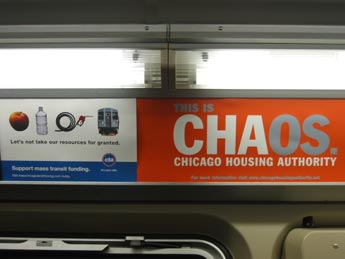
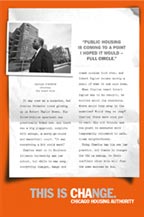

See the old ads, download the new ads, and find out more about the campaign at ChicagoHousingAuthority.net:
“In late 2004, the Chicago Housing Authority (CHA) initiated a public relations campaign to put a new face on their Plan for Transformation, a plan that drastically reshapes the state of public housing in Chicago.
This PR campaign, authored by the advertising giant Leo Burnett, fused Chicago Housing Authority's acronym ‘CHA’ with the word ‘change’, resulting in a new brand identity: CHAnge. There are undoubtedly big changes happening with public housing in Chicago, including massive organizational restructuring within CHA and the tearing down of all high-rise public housing buildings.
Unfortunately, the priorities of CHA haven’t changed at all, and public housing residents are still at the bottom of the list. While the CHAnge campaign has attempted to put a ‘resident empowerment’ spin on the Plan for Transformation, in reality the majority of public housing residents have been adversely affected by the massive restructuring. If you are a single working mother displaced by a home demolition, waiting over 6 months for a voucher to relocate as your children are shifted from school to school, CHAnge feels a lot more like CHAos....
The Plan for Transformation is a $1.6 billion blueprint that includes the demolition of 14,000 public housing units and the displacement of over 20,000 people. Not unlike the ‘urban renewal’ master plans of previous decades, the Plan For Transformation has linked motives. It is pushing poor people out of the now-coveted inner city neighborhoods and increasing the exchange value of existing public land through privatization. Developers such as Dan McLean are making millions building on the land adjacent to former CHA high-rises and getting huge city tax credits to subsidize their development. In addition, the city is making money by selling or leasing former CHA public land to private developers. In this way, large amounts of our city’s housing budget are being transferred into private hands. CHA CEO Terry Peterson was personally implicated in this when he was caught giving CHA bids to contractors like the Habitat Group in exchange for political contributions.”
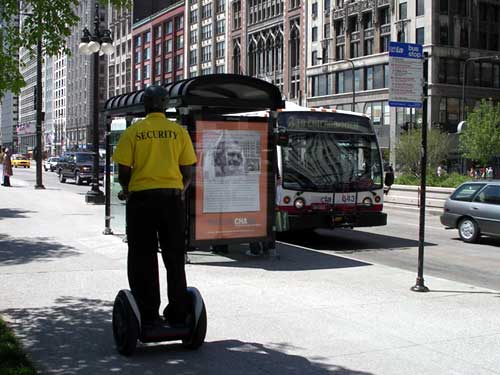
page 19 18 17 16 15 14 13 12 11 10 9 8 7 6 5 4 3 2 1 Older »



